Monitors with adaptive sync technology over HDMI provide various benefits that enhance the overall user experience, particularly for gamers and those requiring high-performance displays. This article explores the key advantages of adaptive sync over HDMI, shedding light on how it improves visual quality and performance.
What is Adaptive Sync?
Adaptive sync is a technology that dynamically adjusts the refresh rate of a monitor to match the frame rate output of the graphics card. This synchronization minimizes screen tearing and stuttering, offering smoother gameplay and visual experiences. Common adaptive sync technologies include NVIDIA G-SYNC and AMD FreeSync.
Understanding HDMI and Adaptive Sync Compatibility
HDMI, or High-Definition Multimedia Interface, is a widely used interface for transmitting audio and video data. Recent versions of HDMI (2.1 and later) have included support for adaptive sync technologies, making it possible for users to enjoy the benefits without needing specialized cables or interfaces.
- HDMI Version 2.0: Basic support for variable refresh rates (VRR).
- HDMI Version 2.1: Full support for enhanced adaptive sync technologies.
Key Benefits of Adaptive Sync over HDMI
1. Enhanced Gaming Experiences
Adaptive sync ensures that the monitor’s refresh rate matches the frame rate of the GPU, which significantly improves the gaming experience by reducing screen tearing, stuttering, and input lag. This makes for a much smoother and visually appealing gaming session.
2. Reduced Screen Tearing
Screen tearing occurs when multiple frames are displayed at once, leading to a disjointed image. Adaptive sync eliminates this issue by aligning the frames from the GPU with the monitor’s refresh rate.
3. Lower Latency
Lower latency is crucial for competitive gaming. Adaptive sync minimizes the delay between the GPU rendering a frame and the monitor displaying it, ensuring faster response times and better precision.
4. Seamless Compatibility
Modern monitors with adaptive sync over HDMI are designed to be plug-and-play, offering seamless compatibility with most GPUs and gaming consoles. This ease of use is particularly beneficial for gamers who use multiple devices.
Compatibility Table
| Adaptive Sync Technology | Compatible HDMI Version | Remarks |
|---|---|---|
| AMD FreeSync | HDMI 2.0 | Basic VRR support |
| AMD FreeSync Premium | HDMI 2.1 | Enhanced VRR and low latency modes |
| NVIDIA G-SYNC | HDMI 2.1 | Full adaptive sync support |
5. Future-Proofing Your Setup
Investing in a monitor with adaptive sync over HDMI is a future-proof decision. As graphics technology evolves, having a monitor that supports adaptive sync ensures that your setup remains compatible with upcoming updates and devices.
6. Versatility Across Devices
Adaptive sync monitors connected via HDMI are not limited to gaming PCs. They can also be used with gaming consoles such as the PlayStation 5 and Xbox Series X, as well as other multimedia devices that support adaptive sync.
Conclusion
Monitors with adaptive sync over HDMI offer a range of benefits that improve visual quality and performance, especially for gamers. From reduced screen tearing and stuttering to lower latency and future-proof compatibility, adaptive sync technologies like AMD FreeSync and NVIDIA G-SYNC provide an enhanced viewing experience. As technology continues to advance, the integration of adaptive sync over HDMI ensures that users can enjoy smoother and more immersive visual experiences across a variety of devices.

